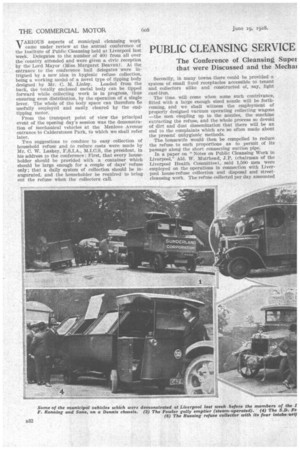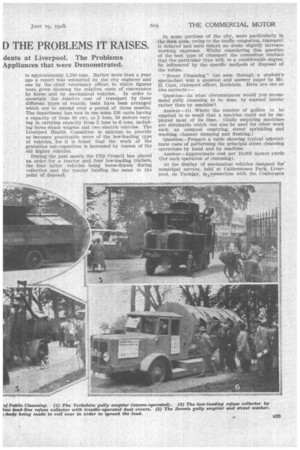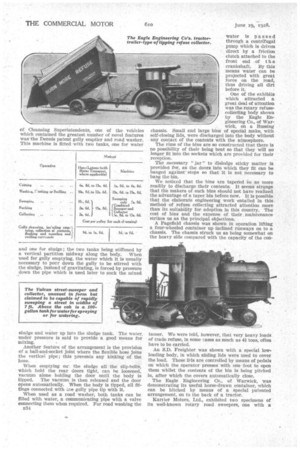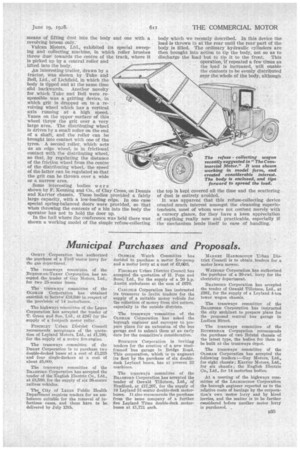PUBLIC CLEANSING SERVICE D THE PROBLEMS IT RAISES.
Page 58

Page 59

Page 60

Page 61

If you've noticed an error in this article please click here to report it so we can fix it.
The Conference of Cleansing Supei that were Discussed and the Mechal dents at Liverpool. The Problems Appliances that were Demonstrated.
TARIOUS aspects of municipal cleansing work V came under review at the annual conference of the institute of Public Cleansing held at Liverpool last week. Delegates to the number of 400 from all over the country attended and were given a civic reception by the Lord Mayor (Miss Margaret Beavan). At the entrance to the conference hall delegates were intrigued by a new idea in hygienic refuse collection, being a working model of a novel type of tipping body designed by Mr. C. M. Linley. Loaded from the back, the totally enclosed metal body can be tipped forward while collecting work is in progress, thus ensuring even distribution, by the operation of a single lever. The whole of the body space can therefore 15e usefully employed and easily cleared by the endtipping motor.
From the transport point of view the principal event of the opening day's session was the demonstration of mechanical vehicles at the Menlove Avenue entrance to Calderstones Park, to which we shall refer later.
Two suggestions to conduce to easy collection of household refuse .and to reduce costs were made by Mr. C. W. Lackey, F.S.I.A., M.I.C.S, the president, in his address to the conference: First, that every householder should be provided with a container which should be large enough for a couple of days' refuse only; that a daily system of collection should be inaugurated, and the householder be required to bring out the refuse when the collectors call. Secondly, in many towns there could be provided a system of small fixed receptacles accessible to tenant and collectors alike and constructed of, say, light cast-iron.
The time. willcome when some such contrivance, fitted with a large enough sized nozzle will be forthcoming, and we shall witness the employment of properly designed vacuum operating collecting wagons —the men coupling up to the nozzles, the machine extracting the refuse, and the whole process so devoid of dirt and dust dissemination that there will be an end to the complaints which are so often made about the presenf unhygienic methods.
The housewife would then be compelled to reduce . the refuse to such proportions as to permit of its passage along the short connecting suction pipe.
In a paper on "Notes on Public Cleansing Work in Liverpool," Aid. W. 1VIuirhead, J.P. (chairman of the• Liverpool Health Committee), said 1,500 men were employed on the operations in connection with Liverpool house-refuse collection and disposal and streetcleansing work. The refuse collected per day amounted to approximately 1,200 tons. Rather more than a year ago a report was submitted by the city engineer and one by the chief veterinary officer, in which figures were given showing the relative costs of conveyance by horse and by mechanical vehicles. In order to ascertain the relative cost of transport by these different types of vehicle, tests have been arranged which are to extend over a period of three months. The department has now in use some 156 carts having a capacity of from 30 cwt. to 2 tons, 50 motors varying in carrying capacity from 2 tons to 6 tons, including three steam wagons and two electric vehicles. The Liverpool Health Committee is anxious to provide as becomes practicable more of the low-loading type of vehicles, for it is found that the work of the gratuities sub-committee is increased by reason of the old higher vehicles.
During the past month the City Council has placed an order for a tractor and four low-loading trailers, the four latter vehicles being horse-drawn during collection and the tractor ha.uling the same to the point of disposal. In some portions of the city, more particularly in the dock area, owing to the traffic congestion, transport is delayed and such delays no doubt slightly increase working expenses. Whilst considering this question of the best type of transport the committee realizes that the particular type will, to a considerable degree, be influenced by the specific methods of disposal of the refuse.
" Street Cleansing" (as seen through a student's spectacles) was a question and answer paper by Mr. H. Cook, transport officer, Rochdale. Here are one or two extracts : Question—in what circumstances would you recommend gully cleansing to be done by manual labour rather than by machine?
Answer—(i) Where the number of gullies to be emptied is so small that a machine could not be employed most of its time. (Gully emptying machines are obtainable which can also be used for other work such as cesspool emptying, street sprinkling and washing, channel damping and flushing.)
Question Prepare a table showing typical approximate costs of performing the principal street cleansing operations by hand and by machine.
Answer—Approximate cost per 10,000 square yards (for each operation of cleansing).
At the display of mechanical vehicles designed for municipal service, held at Calclerstones Park, Liverpool, on Tuesday, imonnection with the Conference of Cleansing Superintendents, one of the vehicles which contained the greatest number of novel features was the Dennis patent gully emptier and road washer. This machine is fitted with two tanks, one for water and one for sludge; the two tanks being stiffened by a vertical partition midway along the body. When used for gully emptying, the water which it is usually necessary to pour down the gully to be stirred with the sludge, instead of gravitating, is forced by pressure down the pipe which is used later to suck the mixed
sludge and water up into the sludge tank. The water, under pressure is said to provide a good means for
mixing. • Another feature of the arrangement is the provision of a ball-and-socket joint where the flexible hose joins the vertical pipe; this prevents any kinking of the hose.
When emptying out. the sludge all the slip-bolts, which hold, the rear doors tight, can he loosened, vacuum alone holding the door until the body is tipped. The vacuum is then released and the door opens automatically. When the body is tipped, all fittings connected with Lne gully pipe tip with it.
When used as a road washer, both tanks can be filled with water, a communicating pipe with a valve connecting them when required. For road washing the n34
water is passed through a centrifugal pump which is driven direct by a friction clutch attached to the front end of t he crankshaft. By this means water can he projected with great force on the road, thus driving all dirt before it.
One of the exhibit which attracted a great deal of attention was the rotary refusecollecting body shown by the Eagle Engineering Co., of Warwick, on a Bussing chassis. Small and large bins of special make, with self-closing lids, were discharged into the body without any contact of the contents with the atmosphere.
The rims of the bins are so constructed that there is no possibility of their being bent so that they will no longer fit into the sockets which are provided for their reception.
The necessary " jar " to dislodge sticky matter is provided for, as the doors into which they fit can be banged against stops so that it is not necessary to bang the bin.
We noticed that the bins are tapered `so as more readily to discharge their contents. It seems strange that the makers of such bins should not have realized the advantage of a taper bin before now. It is possible that the elaborate engineering work entailed in this method of refuse collecting attracted attention more than its suitability for adoption in this country. The cost of bins and the expense of their maintenance strikes us as the principal objections.
A Pagefield chassis was shown in operation lifting a four-wheeled container up inclined runways on to a chassis. The chassis struck us as being somewhat on the heavy side compared with the capacity of the con
tamer. We were told, however, that very heavy loads of trade refuse, in some cases as much as 41 tons, often have to be carried.
An S.D. Freighter was shown with a special lowloading body, in which sliding lids were used to cover the load. These lids are controlled by means of pedals on which the operator presses with one foot to open them whilst the contents of the bin is being pitched in, after which the covers automatically close.
The Eagle Engineering Co., of Warwick, was demonstrating its useful horse-drawn container, which can be hitched by means of a special patented arrangement, on to the back of a tractor.
'Carrier Motors, Ltd., exhibited two specimens of its well-known rotary road sweepers, one with a -means of lifting dust into the body and one with a revolving broom only: Vulcan Motors, Ltd., exhibited its special sweeping and collecting machine, in which roller brushes throw dust towards the centre of the track, where it is picked up by a central roller and
lifted into the body.
An interesting trailer, drawn by a tractor, was shown by Tu.ke and Bell, Ltd., of Lichfield, in which the bpdy is tipped and at the same time slid backwards. Another novelty for which Tuke and Bell were responsible was a gritting device, in which grit is dropped on to a revolving wheel which has a vertical axis running at a high speed. Vanes on the upper surface of this wheel threw the grit over a very large area. The distributing wheel is driven by a small roller on the end of a shaft, and the roller can be brought into contact with one of the tyres. A second roller, which acts as an edge wheel, is in frictional contact with the distributing wheel, so that, by regulating the distance of the friction wheel from the centre of the distributing wheel, • the speed of the latter, can be regulated so that the grit can be thrown over a wide or a narrow area.
Some interesting bodies were shown by F. Kenning and Co., of Clay Cross, on Dennis and Karrier chassis. These bodies provided a fairly large capacity, with a low-loading edge. In one ease special spring-balanced doors were provided, so that when throwing the contents of a bin into the body the operator has not to hold the door up.
In the hall where the conference was held there was shown a working model of the simple refuse-collecting
body which we recently described. In this device the load is thrown in at the rear until the rear part of the body is filled. The ordinary hydraulic cylinders are then brought into action to tip the body, not so as to discharge the load but to tip it to the front. This operation, if repeated a few times as the load is increased, will enable the contents to be evenly distributed Dyer the whole of the body, although the top is kept covered all the time and the scattering of dust is entirely avoided.
It was apparent that this refuse-collecting device created much interest amongst the cleansing superintendents, most of whom were not content merely with a cursory glance, for they have a keen appreciation of anything really new and practicable, especially if the mechanism lends itself to ease of handling.




















































































































